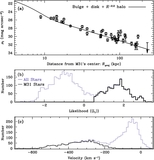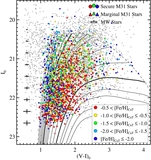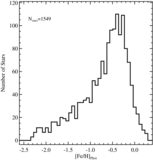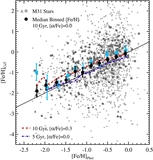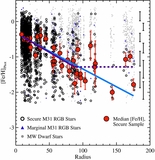Image Details

Caption: Figure 5.
Top panel: metallicity distribution function of the securely identified M31 red giants in our sample, based on the equivalent width of the Ca II triplet absorption lines (Section 3.2). Due to the low S/N of most of our spectra, the errors on any individual [Fe/H]CaT measurement are large. The spectroscopic MDF has a strong, relatively metal-rich peak (at [Fe/H] ~ − 0.5) and a significant tail to metal-poor values. The blue dot-dashed and red dashed histograms show the MDF computed when the sample is reduced to stars with S/N >3 pixel−1, and when only stars that pass the quality cuts discussed in Section 3.2 are included. Bottom panel: the CMD-based metallicity distribution function for the full sample of M31 stars and the subsamples defined in the top panel. The addition of quality cuts on the spectral measurements removes the most uncertain spectroscopic metallicity estimates, and reduces the range of the [Fe/H]CaT measurements to more physically reasonable values. However, it also affects the CMD distribution of the stars. The quality cuts preferentially remove the reddest RGB stars from the sample, resulting in a lower median photometric metallicity (due to a bluer median color) of the sample. In both panels, arrows mark the median values of each MDF.
Copyright and Terms & Conditions
© 2014. The American Astronomical Society. All rights reserved.



